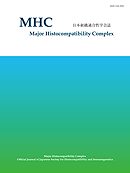
- 3 号 p. 163-
- 2 号 p. 71-
- 1 号 p. 8-
- |<
- <
- 1
- >
- >|
-
U. Shankarkumar2002 年 9 巻 2 号 p. 71-77
発行日: 2002年
公開日: 2017/03/30
ジャーナル フリーThe Parsi community immigrated to India from lran to avoid religious persecution by Muslims during 715AD. They are a tightly knit isolated community numbering 90, 000 living chiefly in Mumbai, India. They have maintained separate identity because of own strict religious tenets and rigidity of caste system prevailing in India. I report here HLA polymorphism in 67 Parsi compared with other populations of India and world. The standard NlH two-stage microlymphocytotoxicity assay was used with a minimum of three sera for a given specificity to define the HLA antigens. The significant observation was, they had the highest percentage gene frequency for HLA B 14 (28%) and HLA A19 (41%). The two locus haplotype analysis showed a significant haplotype frequency (HF) and linkage disequlibrium (LD) for HLA A19-B 14. This observation was concordant with previous studies on Parsis reported in Third Asia-Oceania Histocompatibility Workshop and conference. Molecular subtyping using reverse line blot technique showed that HLA B*1405 (GF = 19%) and HLA B*1401 (GF = 9. 5%) for B 14 while A*3001 (GF = 17. 6%) and A*3303 (GF = 15%) for A19 were the subtypes present. Haplotypes A*3001-B*1401 and A*3303-B*1405 were the significant haplotypes observed among the Parsi community. When the results were compared to other Indian caste groups and major world populations the frequency of HLA B 14 was the highest among the populations reported. These observations could be due to selective pressures operating on the highly inbreeding and diminishing parsi population It will be interesting to know how this genetic diversity is maintained and is there any impact of this variation on the health and disease among Parsi community.
抄録全体を表示PDF形式でダウンロード (3210K) -
EF Kikkawa, M Nakashima, H Kawata, Suyun Li, TK Naruse, H Inoko2002 年 9 巻 2 号 p. 78-83
発行日: 2002年
公開日: 2017/03/30
ジャーナル フリーThe SBT (sequencing based typing) system has many advantages among HLA genotyping methods which have been developed f∞oor high resolution typing. At present, several allele detection systems for SBT were developed. Two SBT methods, Genetic Kit HLA sequencing Assay (VISIBLE) and Sequencing-Based Kit (Applied Biosystems) are being used as routine methods in our laboratory. In this study, in order to evaluate them as reliable SBT technique systems, we have compared accuracy and typing results between them. As a result, typing results of both techniques were in agreement with to each other, revealing that both methods were suitable for HLA high resolution typing due to their reliability and high accuracy.
抄録全体を表示PDF形式でダウンロード (2850K)
- |<
- <
- 1
- >
- >|